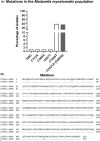Epidemiological cut-off values for itraconazole and ravuconazole for Madurella mycetomatis, the most common causative agent of mycetoma
- PMID: 36005544
- PMCID: PMC9804462
- DOI: 10.1111/myc.13509
Epidemiological cut-off values for itraconazole and ravuconazole for Madurella mycetomatis, the most common causative agent of mycetoma
Abstract
Background: Eumycetoma is a neglected tropical disease. It is a chronic inflammatory subcutaneous infection characterised by painless swellings which produce grains. It is currently treated with a combination of itraconazole and surgery. In an ongoing clinical study, the efficacy of fosravuconazole, the prodrug of ravuconazole, is being investigated. For both itraconazole and ravuconazole, no clinical breakpoints or epidemiological cut-off values (ECV) to guide treatment are currently available.
Objective: To determine tentative ECVs for itraconazole and ravuconazole in Madurella mycetomatis, the main causative agent of eumycetoma.
Materials and methods: Minimal inhibitory concentrations (MICs) for itraconazole and ravuconazole were determined in 131 genetically diverse clinical M. mycetomatis isolates with the modified CLSI M38 broth microdilution method. The MIC distributions were established and used to determine ECVs with the ECOFFinder software. CYP51A sequences were sequenced to determine whether mutations occurred in this azole target gene, and comparisons were made between the different CYP51A variants and the MIC distributions.
Results: The MICs ranged from 0.008 to 1 mg/L for itraconazole and from 0.002 to 0.125 mg/L for ravuconazole. The M. mycetomatis ECV for itraconazole was 1 mg/L and for ravuconazole 0.064 mg/L. In the wild-type population, two CYP51A variants were found for M. mycetomatis, which differed in one amino acid at position 499 (S499G). The MIC distributions for itraconazole and ravuconazole were similar between the two variants. No mutations linked to decreased susceptibility were found.
Conclusion: The proposed M. mycetomatis ECV for itraconazole is 1 mg/L and for ravuconazole 0.064 mg/L.
Keywords: CYP51A; Madurella mycetomatis; azoles; epidemiological cut-off values; eumycetoma; mycetoma.
© 2022 The Authors. Mycoses published by Wiley-VCH GmbH.
Conflict of interest statement
None to declare.
Figures




Similar articles
-
An updated list of eumycetoma causative agents and their differences in grain formation and treatment response.Clin Microbiol Rev. 2024 Jun 13;37(2):e0003423. doi: 10.1128/cmr.00034-23. Epub 2024 May 1. Clin Microbiol Rev. 2024. PMID: 38690871 Free PMC article. Review.
-
Eumycetoma causative agents are inhibited in vitro by luliconazole, lanoconazole and ravuconazole.Mycoses. 2022 Jun;65(6):650-655. doi: 10.1111/myc.13442. Epub 2022 May 6. Mycoses. 2022. PMID: 35398930 Free PMC article.
-
The combination of manogepix and itraconazole is synergistic and inhibits the growth of Madurella mycetomatis in vitro but not in vivo.Med Mycol. 2023 Nov 6;61(11):myad118. doi: 10.1093/mmy/myad118. Med Mycol. 2023. PMID: 37960934 Free PMC article.
-
Inhibiting DHN- and DOPA-melanin biosynthesis pathway increased the therapeutic value of itraconazole in Madurella mycetomatis infected Galleria mellonella.Med Mycol. 2022 Feb 2;60(2):myac003. doi: 10.1093/mmy/myac003. Med Mycol. 2022. PMID: 35064672 Free PMC article.
-
Mycetoma caused by Madurella mycetomatis: a neglected infectious burden.Lancet Infect Dis. 2004 Sep;4(9):566-74. doi: 10.1016/S1473-3099(04)01131-4. Lancet Infect Dis. 2004. PMID: 15336224 Review.
Cited by
-
An update on the development of novel antifungal agents for eumycetoma.Front Pharmacol. 2023 May 18;14:1165273. doi: 10.3389/fphar.2023.1165273. eCollection 2023. Front Pharmacol. 2023. PMID: 37274106 Free PMC article. Review.
-
The potential role and mechanism of circRNA/miRNA axis in cholesterol synthesis.Int J Biol Sci. 2023 May 29;19(9):2879-2896. doi: 10.7150/ijbs.84994. eCollection 2023. Int J Biol Sci. 2023. PMID: 37324939 Free PMC article. Review.
-
A Longstanding Case of Black Grain Mycetoma in a Somalian Male Patient: A Case Report.Clin Case Rep. 2025 Apr 3;13(4):e70394. doi: 10.1002/ccr3.70394. eCollection 2025 Apr. Clin Case Rep. 2025. PMID: 40190364 Free PMC article.
-
An updated list of eumycetoma causative agents and their differences in grain formation and treatment response.Clin Microbiol Rev. 2024 Jun 13;37(2):e0003423. doi: 10.1128/cmr.00034-23. Epub 2024 May 1. Clin Microbiol Rev. 2024. PMID: 38690871 Free PMC article. Review.
-
Itraconazole resistance in Madurella fahalii linked to a distinct homolog of the gene encoding cytochrome P450 14-α sterol demethylase (CYP51).PLoS Negl Trop Dis. 2025 Mar 27;19(3):e0012623. doi: 10.1371/journal.pntd.0012623. eCollection 2025 Mar. PLoS Negl Trop Dis. 2025. PMID: 40146733 Free PMC article.
References
-
- Zijlstra EE, van de Sande WWJ, Welsh O, Mahgoub ES, Goodfellow M, Fahal AH. Mycetoma: a unique neglected tropical disease. Lancet Infect Dis. 2016;16(1):100‐112. - PubMed
-
- van de Sande W, Fahal A, Ahmed SA, et al. Closing the mycetoma knowledge gap. Med Mycol. 2018;56(suppl_1):S153‐S164. - PubMed
-
- Scolding PS, Fahal AH, Yotsu RR. Drug therapy for mycetoma. Chochrane Database Syst Rev. 2018;7:CD013082.
MeSH terms
Substances
Grants and funding
LinkOut - more resources
Full Text Sources

